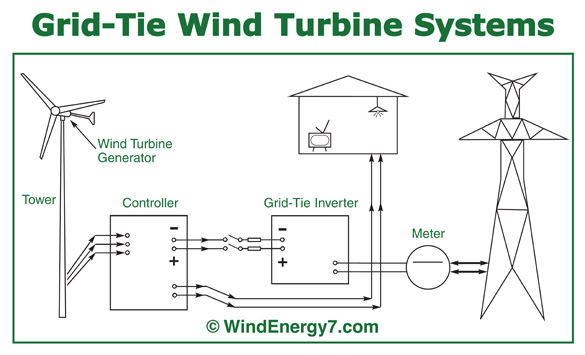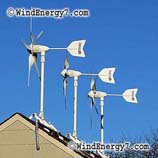 We get so many calls at WindEnergy7 from folks who want to install a wind system. One of the top things that customers say is, “I want to save on utility bills and and maybe make some money” So, at WindEnergy7 we try to make this happen for our customers. There are several factors to consider and calculate to see what your wind project can do, financially. Local Utility and State Net Metering policy is one factor that you have to find out about and understand.
We get so many calls at WindEnergy7 from folks who want to install a wind system. One of the top things that customers say is, “I want to save on utility bills and and maybe make some money” So, at WindEnergy7 we try to make this happen for our customers. There are several factors to consider and calculate to see what your wind project can do, financially. Local Utility and State Net Metering policy is one factor that you have to find out about and understand.
Grid-Tie or On-Grid – A term used for energy systems that are connected to the normal utility system of a home or business. With a grid-tie system your system becomes an extension of your existing utility supply. Thus if it is not running, a windmill on a still day, or a solar panel at night, you still have electricity flowing through your meter from the electrical utility, same as normal, meter running forward. In case of any downtime or maintenance of your systems you will not be without power.
RoofMill™ CLICK ON THE VIDEO BELOW TO SEE IN ACTION, INSTALL and OPERATION
RoofMill™ CLICK ON THE VIDEO ABOVE TO SEE IN ACTION, INSTALL and OPERATION
In reverse, a Grid-Tied or On-Grid system will be generating more electrical power than you use, example a windy night with all lights and household appliances are off, your meter actually running backward as you generate clean electricity to the grid that will be used by neighbors and others on the grid.

Net Metering – is the electricity policy for consumers who own wind or solar power generation systems. Net metering is the rules of your state and utility company combined. These rules vary by state AND utility provider, some better than others, thus it has much to do with the ROI (return on investment) of your system. The ideal has your existing electricity meter spinning backwards, effectively banking excess electricity production for future credit. The rules dictate if and how long you can keep your banked credits, how much the credits are worth (retail/wholesale), etc.
Net Metering is generally a consumer-based renewable energy incentive. While it is important to have Net Metering available for any consumer that interconnects their renewable generator to the grid, this form of renewable incentive places the burdens of pioneering renewable energy primarily upon fragmented consumers.
Net Metering Law – In the U.S.A., as part of the Energy Policy Act of 2005, under Sec. 1251, all public electric utilities are now required to make available upon request net metering to their customers.
‘‘(11) NET METERING.—Each electric utility shall make available upon request net metering service to any electric consumer that the electric utility serves. For purposes of this paragraph, the term ‘net metering service’ means service to an electric consumer under which electric energy generated by that electric consumer from an eligible on-site generating facility and delivered to the local distribution facilities may be used to offset electric energy provided by the electric utility to the electric consumer during the applicable billing period.
Part of the homework that a customer needs to do is:
(1) Look at their Net Metering for state and their utility company here. dsire.org
(2) Look at their bill for cost per kwH (kilowatt hour), compare to net metering information. Need to know your cost per kwH to calculate savings & ROI (return on investment).
(3) Look at their local wind map, need 11mph or better average to be successful, zone 2 or higher on DOE Wind Maps by State.
(4) Look at your site, do you have room for a turbine, usually an acre or more is best. Recently there have been urban residential installs. So, it’s possible to put one in a suburban or urban neighborhood but takes more negotiating with zoning, code enforcement and others. Most small wind turbines are put into farm-ranch lots of an acre or more.
Now, I have many customers and projects and get customers who call and just want this done easy. Many want more consultation and have questions. No problem at all, we try to provide very complete kits, information, and the service you require.
We can help you prove, plan, and execute your personal wind project or develop your wind energy plans. If you are interested in starting a wind project for your residence or acreage, contact us. To Buy a Wind Turbine or Become a Dealer, Please fill out our Contact Form. The system will automatically send you some additional info.
Tags: colorado, colorado school, community wind project, net metering, residential windmill, school district wind turbine, small wind turbine, wind energy, wind turbine, wray colorado school





I live in a townhome (sometimes called a townhouse) by a river with lots of trees. I would love a wind tower but the size of the lot and the inconsistent wind leaves me out of this option.
However, I do think I can put 3-4 solar panels on my back roof. I think these panels are lighter weight now and have the potential to provide all and more of my electric needs.
How do I go about getting the county supervisors to rush approval of this effort?
[…] you are interested in a small wind turbine, I recommend you start with this post about Net Metering. Follow the links and info there and then contact me with questions or purchase needs. I’m […]
[…] states and utility providers do not have Net Metering support for Grid-Tied systems. So the consumer cannot tie a wind turbine system to the grid, or gets no […]
[…] If any of you don’t understand Net-Metering, read my tutorial on net metering. […]
I’m interested in your products on several levels and wonder if I may contact you by telephone and if so what is your number?
Thank you, Mike Schwab
214-783-9949
The KWh for my home in town is 1800, so I am trying to figure out what I can do for our house we are moving onto our farm. The house is over 100 yrs old and as soon as it is moved I will start renovating and upgrading it. I am planning on trying a lot of inovations for it. One is a rainwater catch system and another is a heated floor system. It will be on 200 acres out in the country so no limitations by city codes. I am hoping that with heave insulation in walls, attic and windows and doors I can drop heating and cooling costs thus reducing energy consumption and costs. I hope to cut the 1800HWh down by 30%. What type wind of system would you think would help cut costs further? BTW, Our farm is near Lott, Texas just southeast of Waco.
Thanks,
Ron
[…] rooftop unit you were looking at is $4800 for Grid-Tie system with battery back-up. $3200 for Off-Grid system. That has every component with it (except […]